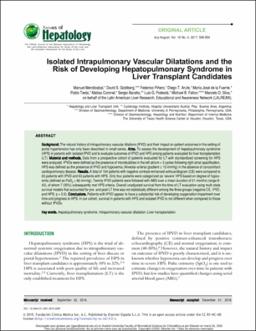Isolated Intrapulmonary Vascular Dilatations and the Risk of Developing Hepatopulmonary Syndrome in Liver Transplant Candidates.

View/
Date
2017-08-01Author
Mendizabal, Manuel.
Goldberg, DS.
Piñero, Federico.
Arufe, Diego.
De la Fuente, María J.
Testa, Pablo.
Coronel, Matias.
et al.
Metadata
Show full item recordAbstract
BACKGROUND:
The natural history of intrapulmonary vascular dilations (IPVD) and their impact on patient outcomes in the setting of portal hypertension has only been described in small series.
AIMS:
To assess the development of hepatopulmonary síndrome (HPS) in patients with isolated IPVD and to evaluate outcomes of IPVD and HPS among patients evaluated for liver transplantation (LT).
MATERIAL AND METHODS:
Data from a prospective cohort of patients evaluated for LT with standardized screening for HPS were analyzed. IPVDs were defined as the presence of microbubbles in the left atrium > 3 cycles following right atrial opacification. HPS was defined as the presence of IPVD and hypoxemia (Alveolar-arterial gradient ≥ 15 mmHg) in the absence of concomitant cardiopulmonary disease.
RESULTS:
A total of 104 patients with negative contrast-enhanced echocardiogram (CE) were compared to 63 patients with IPVD and 63 patients with HPS. Only four patients were categorized as ‘severe’ HPS based on degree of hipoxemia (defined as PaO2 < 60 mmHg). Twenty IPVD patients were followed with ABG over a mean duration of 21 months (range 9-43), of whom 7 (35%) subsequently met HPS criteria. Overall unadjusted survival from the time of LT evaluation using multi-state survival models that accounted for pre- and post-LT time was not statistically different among the three groups (negative CE, IPVD, and HPS; p > 0.5).
CONCLUSIONS:
Patients with IPVD appear to have a substantial risk of developing oxygenation impairment over time and progress to HPS. In our cohort, survival in patients with HPS and isolated IPVD is not different when compared to those without IPVDs.

